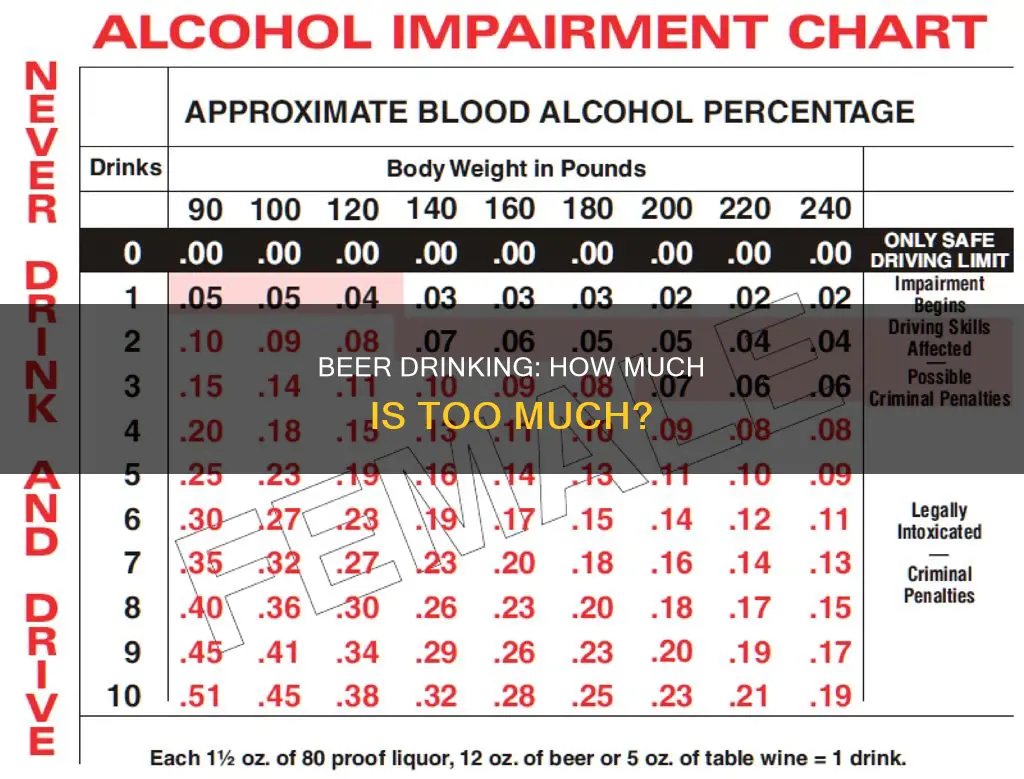
Alcohol is a depressant that acts on the central nervous system. It slows down brain activity, impairing judgment and coordination, and can also cause a feeling of relaxation due to the release of dopamine. The amount of alcohol required to induce drunkenness varies from person to person and is influenced by factors such as body weight, height, muscle mass, food consumption, alcohol tolerance, and the alcohol's strength. Generally, women tend to get drunk faster than men, and drinking on an empty stomach leads to quicker intoxication. It is important to drink responsibly and be aware of the risks associated with excessive alcohol consumption, including health issues and impaired driving ability.
| Characteristics | Values |
|---|---|
| Amount of alcohol | The more alcohol you drink, the more likely you are to get drunk. |
| Frequency of drinking | Drinking a large amount of beer over a short period will lead to quicker intoxication. |
| Food consumption | Drinking on an empty stomach will result in faster intoxication. |
| Body weight | You will get drunk faster if you weigh less and have a low percentage of body fat. |
| Height | Shorter people will require less alcohol to get drunk than taller people. |
| Muscle mass | The more muscle mass you have, the more beer it will take to get you drunk. |
| Gender | Women tend to get drunk more quickly than men. |
| Alcohol tolerance | You will get drunk faster if you are not a regular drinker. |
| ABV | The higher the ABV, the more alcohol is in a drink. |
What You'll Learn

Weight, height, and muscle mass
- Weight: In general, the less a person weighs, the more they will be affected by a given amount of alcohol. People with a higher body mass tend to have a lower blood alcohol concentration (BAC) than those with a lower body mass when consuming the same number of drinks.
- Height: Taller individuals may have a higher alcohol tolerance due to their increased body mass. However, height can also influence the distribution of alcohol throughout the body, which may impact intoxication levels.
- Muscle Mass: Muscle tissue contains a higher water percentage than fat tissue. Since alcohol distributes through body water, individuals with higher muscle mass may experience a more diluted effect of alcohol, leading to a higher tolerance. Additionally, muscle mass can influence the rate of alcohol metabolism, as muscle tissue is involved in this process.
It is important to note that these factors interact with each other and other variables, such as sex, age, and drinking habits, to determine an individual's overall alcohol tolerance and BAC. For example, men tend to have a higher muscle mass percentage than women, which may contribute to their typically higher alcohol tolerance. However, women tend to have lower body weight and higher body fat percentage, which can increase their BAC relative to men.
To drink responsibly, it is recommended to follow guidelines such as drinking in moderation, not drinking on an empty stomach, staying hydrated, and limiting consumption to one drink per hour. These practices can help individuals maintain a safe BAC and avoid the negative health effects of excessive alcohol consumption.
Joe Biden's Beer Habits: A Closer Look
You may want to see also

Food consumption
The amount of beer one can drink before getting drunk depends on various factors, including food consumption, body size, weight, age, and health. Food consumption plays a significant role in how alcohol is absorbed and metabolized by the body.
When alcohol is consumed on an empty stomach, it passes into the small intestine more quickly, as the stomach is not occupied with digesting food. The small intestine has a larger surface area for absorption, allowing alcohol to enter the bloodstream faster. As a result, drinking on an empty stomach can lead to faster intoxication.
On the other hand, when there is food in the stomach, the stomach slows down the process of alcohol absorption. The stomach is busy digesting the food, causing alcohol to move out of the stomach more slowly. This delay in absorption gives the body more time to metabolize the alcohol, potentially reducing the severity of intoxication.
It is recommended to eat before and while consuming alcohol to slow down the absorption of alcohol and reduce the risk of negative effects. Eating food can also help prevent a hangover, as it provides the body with nutrients and energy to process the alcohol.
However, it is important to note that while food consumption can influence the absorption and metabolism of alcohol, it does not completely determine how much beer one can drink before getting drunk. The amount of beer consumed, the rate of consumption, and other individual factors also play a role in intoxication levels.
Beer Ads: Drinking on the Job?
You may want to see also

Alcohol tolerance
It is important to note that alcohol tolerance can lead to, or be a sign of, alcohol dependence. Heavy and regular alcohol consumption can increase alcohol tolerance and contribute to the development of alcohol use disorder. Furthermore, chronic alcohol use can damage the liver, leading to a reduced ability to metabolise alcohol effectively, which can result in higher BAC and more rapid intoxication.
The development of alcohol tolerance can have negative consequences. With tolerance, individuals may not experience the typical signs of intoxication, such as vomiting or passing out, and may reach higher and more toxic BAC levels. This can lead to physical damage and impairment without the individual's knowledge. Additionally, tolerance can increase the risk of alcohol use disorder and physical addiction.
To reduce alcohol tolerance, it is recommended to abstain from alcohol for a significant period. For most people, a few weeks without alcohol can significantly lower tolerance levels.
Beer After Covid Recovery: What You Should Know
You may want to see also

Alcohol by volume (ABV)
Alcohol by volume, or ABV, is a metric used to measure how much alcohol is in an alcoholic drink. ABV specifically measures the ethanol in a drink, which is the organic compound made by wort that goes through a fermentation process to create alcohol.
In the US, a standard drink is defined as 14 grams (or 0.6 ounces) of pure alcohol. This is the equivalent of 12 ounces of beer (one bottle) at 5% ABV, 8 ounces of malt liquor at 7% ABV, 5 ounces of wine at 12% ABV, or 1.5 ounces of hard liquor (one shot) at 40% ABV.
The ABV of a drink can affect how it tastes. Drinks with higher alcohol content tend to be more bitter, and you may be able to taste the alcohol more. For example, liquor, which has a higher ABV than beer, will usually have a stronger taste.
The ABV of a drink can also affect how quickly you feel its effects. A drink with a higher ABV will affect your body more quickly than a drink with a lower ABV. For example, you might drink two or three 5% ABV beers before feeling its effects, but just one shot of 40% ABV liquor may be enough to make you feel drunk.
It's important to note that the effects of alcohol can vary from person to person and are influenced by factors such as weight, age, sex, metabolism, and how often you drink. Additionally, drinking on an empty stomach can cause alcohol to be absorbed into the bloodstream more quickly, leading to faster intoxication.
To drink responsibly, it's recommended to stay within the moderate drinking guidelines: up to one drink per day for women and up to two drinks per day for men. Binge drinking and chronic drinking can be dangerous and lead to negative health effects.
Beer and Non-Alcoholic Beer: Can They Mix?
You may want to see also

Sex and gender
There are several differences in how alcohol affects men and women. Firstly, women tend to have a higher blood alcohol concentration (BAC) than men after consuming the same amount of alcohol. This is because women generally have a higher body fat percentage and less body water than men, and alcohol is stored in body fat and distributed in body water. As a result, women experience the effects of alcohol for a longer time than men.
Men and women also have different reasons for drinking alcohol. Adolescent boys are more likely to drink alcohol out of curiosity or a desire for risk-taking, while adolescent girls are more likely to drink to alleviate stress, social isolation, and psychological distress. Additionally, women are more likely to drink to cope with anxiety, and alcohol has greater anxiolytic effects on women than men.
Alcohol also affects the brains of men and women differently. The prefrontal cortex, which is responsible for executive functions such as decision-making, working memory, and attention, is still developing during adolescence. Binge drinking during this time can disrupt this development, and the effects are more pronounced in boys and young men than in girls and young women.
Furthermore, gonadal hormones, such as estradiol and progesterone, interact with dopamine, a neurotransmitter that plays a crucial role in reward processing and associative learning of alcohol-related cues. Estradiol enhances the stimulating effect of alcohol on dopamine neurons, increasing the rewarding properties of alcohol for women.
Alcohol also has different health risks for men and women. Women who drink at least one glass of alcohol per day are more likely to develop breast cancer than those who do not consume alcohol. Women who drink also face higher risks of heart disease and liver inflammation than men. On the other hand, men who consume alcohol are more likely to commit suicide and experience sexual dysfunction and reduced fertility. Men are also more likely to behave aggressively while drinking, increasing the risk of physical or sexual assault.
Finally, there are differences in how alcohol affects the menstrual cycle and pregnancy. Alcohol can disrupt the menstrual cycle in women and increase the risk of unintended pregnancy. Alcohol use during pregnancy can harm the developing fetus, leading to fetal alcohol spectrum disorder (FASD) and causing morphological, cognitive, and motor deficits in the child.
Old Beer: Is It Safe to Drink After Three Months?
You may want to see also
Frequently asked questions
This depends on a variety of factors, including your weight, height, muscle mass, body fat percentage, alcohol tolerance, and whether you have food in your stomach. Generally, the more you drink, the more likely you are to get drunk, and drinking on an empty stomach will result in faster intoxication.
Binge drinking is defined as consuming four or more drinks in about two hours for women and five or more drinks in about two hours for men. This typically raises a person's blood alcohol concentration (BAC) to 0.08% or higher, which is the legal limit for driving in most states.
Signs of intoxication include irregular breathing, low body temperature, loss of motor control, and nausea and vomiting.







